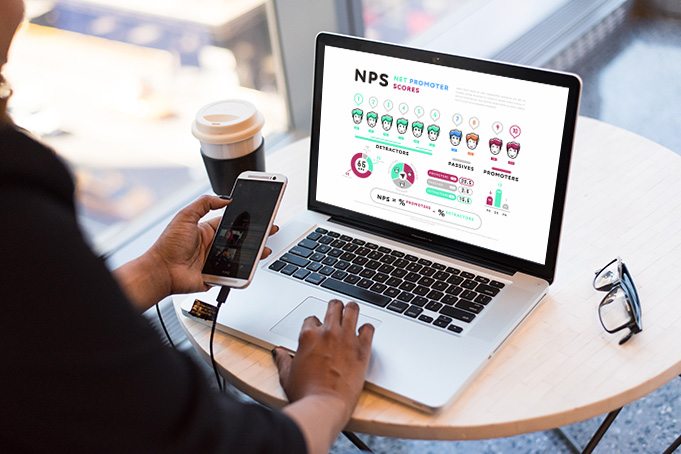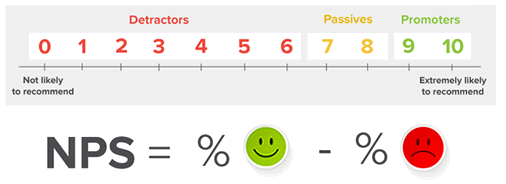The Net Promoter® Score (a registered trademark of Fred Reichheld, Satmetrix, and Bain & Company), or customer recommendation index, is a type of question that you can choose for your online studies on the AreYouNet platform.
This is the most well-known and best-appreciated measurement for collecting data and acting on customer loyalty. You can easily measure satisfaction, loyalty, the power of recommendation and the quality of products and services. The NPS can be readily implemented as a barometer to measure progress over time and observe the impact of actions on customer satisfaction from one month to the next.
Ask for our support
The Net Promoter® Score (NPS) is valued for its simplicity. You ask only one question: “Would you recommend our products and services to those around you?”
An 11-point scale, where 0 = not at all and 10 = certainly, is used to separate promoters, detractors and passive customers.
| Promoters answer with 9 or 10. They appreciate products and services. They are loyal customers and enthusiastic ambassadors who recommend the brand to other potential buyers | |
| Detractors answer with 6 or less. They are not particularly thrilled with products or services. Most probably, they will not purchase again and could even harm the company’s reputation with negative word-of-mouth. | |
| Passive customers give a 7 or 8. They are reasonably satisfied but could easily go to the competition. They will most probably not share their negative opinion but are not enthusiastic enough about products or services to promote them. |
NPS is easy to establish: Net Promoter® Score = % of Promoters – % of Detractors. But be careful: an NPS score can be calculated in different ways. For a score of 10, you could have 50% of promoters and 40% of detractors, but this could also be 20% of promoters, a majority of passive customers, and 10% of detractors.
Depending on analysis and distribution, the result is not the same. You must always go beyond calculations to give meaning to the Net Promoter® Score. Let’s take the example of Satmetrix, the owner of the Net Promoter® Score. Each year, Satmetrix publishes its reference report that ranks American companies according to the customer recommendation index. Their questionnaire has two open questions in addition to the NPS question.
1. On a scale of 0 to 10 with 10 being extremely likely, how likely are you to recommend our company to a friend or colleague?
2. Why did you give us that score?
3. What can we do to earn a 10?

We recommend that you thank all respondents. To do this, create exit pages at the end of the questionnaire with a specific message for each of the three segments.
Promoters: Identify your satisfied customers and encourage them to share their experience in the context of a testimonial or suggest they pre-test your products or services.
Detractors: An automatic dissatisfaction alert will be your ally for immediate intervention towards detractors. Reassure them that their concerns are being taken into account. Keep in mind that a detractor is more likely to become a loyal customer than a customer who never complains.
Passives: The NPS is a good indicator for describing the positive and negative behavior of customers who recommend (or don’t recommend) a company. However, since the passive customer segment is heterogeneous, NPS is unable to predict their behavior. When you analyze results, don’t forget that passive customers can also spread negative word-of-mouth, so remember to check how these customers perceive things. Contact them to see what you can do to transform them into promoters, rather than letting them slide into the detractor group.
If you want to implement the NPS measurement for your online surveys, contact us using this form or call us at +33 1 57 42 42 42.
JOIN THE THOUSANDS OF AREYOUNET USERS AND MAKE YOUR STUDIES INDEPENDENTLY.
Discover the solution to make the right decisions

Hello
Let's talk directly